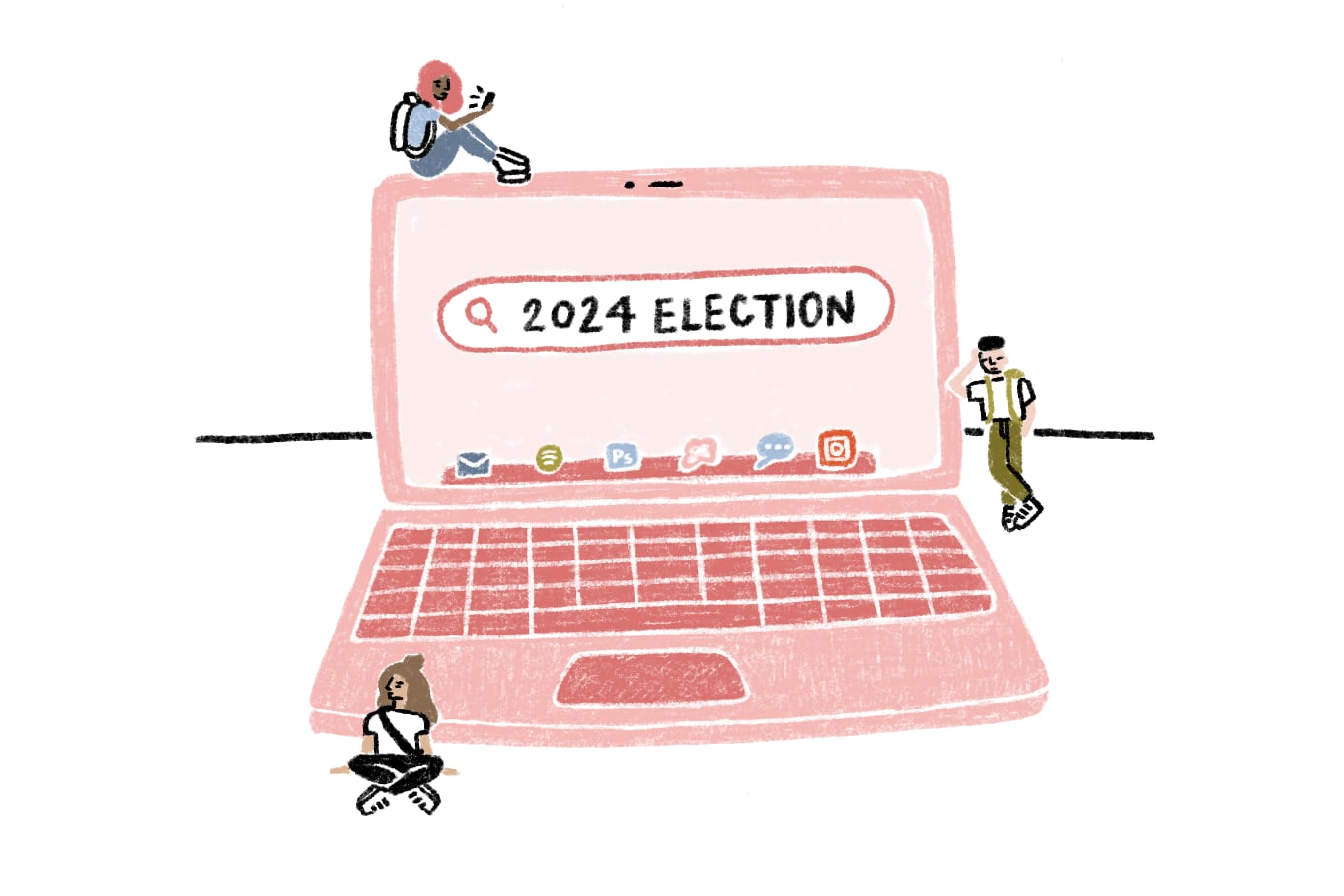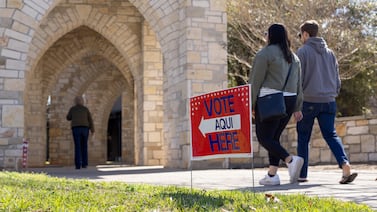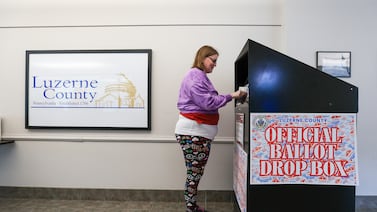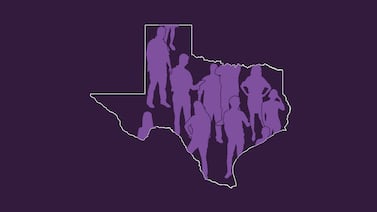This is republished as part of a series in collaboration with the Headway Election Challenge. Chalkbeat and Headway at The New York Times will ask young people to share their insights and perspectives throughout the 2024 presidential election.
Throughout 2024, Headway and Chalkbeat, a nonprofit news organization focused on education in America, have been in conversation with teenagers about the upcoming presidential election.
We’ve asked these teenagers some big questions: How are you engaging with the election? Why are you engaged, or why not? What issues matter to you? So far, we’ve heard from a broad range of students, from self-described political junkies to those more hesitant or uninvolved. In total, we’ve exchanged messages with nearly 1,500 students nationwide.
With each questionnaire, we also invited students to ask us their own questions about the election. Here’s a synthesis of what we’ve heard from them.
What are the candidates’ policies?
The two major candidates, Vice President Kamala Harris and former President Donald J. Trump, have very different records and plans. Maggie Astor, a New York Times reporter covering the election, contacted both candidates’ campaigns and reviewed hundreds of interviews, statements, policy papers, bills, and agency actions to build a guide to each candidate’s key policies.
The guide outlines both Trump’s and Harris’ stances on major issues like abortion, climate change, crime, democracy, the economy, foreign policy, immigration, and the Israel-Gaza conflict. Check it out here, and save the link, as more topics will be added in the coming weeks.
How does the electoral process work?
While the specifics of what happens during an election cycle may vary, the overall electoral process — the steps candidates, campaigns, and voters take to prepare for and participate in Election Day — tends to follow a set order.
First, individuals interested in running for president officially declare their candidacy. Campaigning can begin years before Election Day. These candidates, who aren’t yet official nominees of any political party, campaign by holding town halls and rallies, competing at debates and doing interviews with news outlets. Eventually, the process leads to the primaries and caucuses, where voters select their preferred party’s nominee. These primaries and caucuses occur on the state level, with each state having its own schedule and rules.
Four years ago, Times journalists Sarah Almukhtar, Matt Flegenheimer, Umi Syam, and Eden Weingart created a guide to help readers navigate the intricacies of the 2020 presidential election’s primaries and caucuses. Their definitions remain relevant today:
Primaries are reasonably straightforward: Voters vote, and their votes go to candidates who hope to receive more votes than the other candidates.
Caucuses are like this in spirit, but with a dash of municipal sausage-making and D.M.V.-style chaos.
Generally, supporters for various candidates sit or stand together in groups. A head count is conducted. And if a candidate doesn’t reach a certain threshold of support — say, 15 percent of attendees at a caucus site — the group is deemed “nonviable,” and its members realign with other clusters before a final count is made.
After the votes from the primaries and caucuses are tallied, each party coalesces around the winning candidate. Next, the candidates announce their vice-presidential running mates. Finally, the candidates head to their respective party’s national convention, where they are formally nominated by the party’s state delegates.
The conventions themselves are multi-day events full of speeches and presentations, nearly all focused on telling the story of the campaign to a national audience. More than 200,000 words were spoken at this year’s Democratic National Convention and Republican National Convention combined. The Times reporter Jonathan Corum analyzed all those words, which you can check here.
As Election Day approaches, the presidential candidates continue to persuade voters through more debates, speeches, rallies, and media interviews. In many states, eligible voters can vote early.
In this year’s election, early voting has already begun in many states, and voter registration deadlines have begun to pass in some. Here’s a full guide to the key dates in each state. (We also received a lot of questions about how results are counted, which you can read about here.)
Once voting concludes, the ballots are counted in each state. This is where the Electoral College comes into play. In almost every state, the candidate who wins the most votes secures all of the state’s electoral votes. (Maine and Nebraska allocate some of their electoral votes by congressional district). There are 538 total electoral votes, and the candidate who earns at least 270 is declared president-elect. The president-elect officially takes office at noon on Inauguration Day, which is usually on Jan. 20.
Why do we still use the Electoral College?
The Electoral College was a clear point of confusion for teenagers. In 2016, Hillary Clinton won the popular vote but still lost the election to Donald Trump because she lost the Electoral College. Teenagers wondered why this system remains a part of our electoral process.
In 2022, The New York Times published a comprehensive guide to the Electoral College. In this guide, the Times fellow Allyson Waller explained that although a majority of the public supports the Electoral College’s abolition, it remains politically contentious “since Republicans currently benefit from the electoral clout of less populous, rural states.”
She continues:
In 2020, Gallup reported that 61 percent of Americans supported abolishing the Electoral College in favor of the popular vote. However, that support diverges widely based on political parties, with support from 89 percent of Democrats and only 23 percent of Republicans.
One route to changing the system would be a constitutional amendment, which would require two-thirds approval from both the House and Senate and ratification by the states, or a constitutional convention called by two-thirds of the state legislatures.
Some hope to reduce the Electoral College’s importance without an amendment. Fifteen states and the District of Columbia, which together control 195 electoral votes, have signed on to an interstate compact in which they pledge to grant their votes to the winner of the national popular vote. The local laws would take effect only once the compact has enough states to total 270 electoral votes.
If you want to dive deeper into what fake electors are, how many electoral votes it takes to win, or if there could ever be a tie, you can read more here.
For this year’s election, Times journalists Lily Boyce, Jon Huang, and Blacki Migliozzi created an interactive that allows you to game out how Harris or Trump could reach 270 electoral votes, depending on which swing states they win. You can play that here.
How do polls work, and can we trust them?
Many teenagers had questions about polls. Times reporter Kaleigh Rogers broke down how election polling works here. If you’re short on time, she also explains it in a video. Here’s the gist:
The golden rule: Never put too much stock in a single poll. Remember that polls are a snapshot of how people were feeling at a particular moment in time; they are subject to error and are best understood in aggregate, such as through New York Times polling averages.
But when you do want to understand more about a single poll, consider the so-called P.S.T. No, not Pacific Standard Time — take a look at the pollster that conducted the poll, the sample population surveyed, and the time frame in which it was conducted.
Now that you’ve been introduced to the importance of considering a survey’s pollster, sample, and time frame, you can read Rogers’ explanation for each of these terms in clear, easy-to-understand detail here.
How can I tell if the information I’m consuming is accurate and unbiased?
In 2022, Times technology reporter Tiffany Hsu explored how teachers are helping students navigate a media landscape littered with misinformation. The article touched on a number of strategies that teachers and students can employ to improve their ability to find verified facts and mitigate bias.
A New York Times Opinion article about misinformation by Charlie Warzel — later incorporated into a lesson plan from The New York Times Learning Network — argued that consuming accurate and unbiased information requires going beyond a single source. One teacher encourages students to remember the acronym SIFT:
1. Stop.
2. Investigate the source.
3. Find better coverage.
4. Trace claims, quotes, and media to the original context.
You can find more resources here in the lesson plan from The New York Times Learning Network.
How are election results counted?
There are two main types of ballots counted during an election: in-person ballots cast at polling stations on Election Day, and absentee or mail-in ballots, which voters submit either by mail or by hand before Election Day.
For in-person voting on or before Election Day, voters go to designated polling places and fill out ballots.
Absentee or mail-in ballots, which in this election are starting to go out, are becoming more popular among voters. There are state-specific rules for when they should be returned — you can see your state’s deadlines for registration and voting here.
At the close of voting on Election Day, all ballots are sent to state authorities for official counting. Each state has established procedures for processing in-person, absentee, and mail-in ballots. After all votes are tallied and certified, the state’s overall result determines which candidate receives its electoral votes. Once a candidate reaches 270 electoral votes, he or she wins the presidency. The results are then formally sent to Congress, concluding the election process.
In 2024, for the second presidential election in a row, we may not know the winner until days after Election Day. One of those reasons is the rise in popularity of mail-in voting. In an article about mail-in ballot delays, Times reporter Nick Corasaniti explains why:
Counting mail ballots takes more time because there are more steps involved. A variety of security measures, including signature verification and ensuring that voters did not also try to vote in person, are required. Election officials must open the ballots and flatten them before they can be put in a tabulator to be counted.
Corasaniti adds: “If a winner is not declared on election night, it will not necessarily point to failures in the process. More likely, it will be a result of the intense security measures required for counting mail-in ballots.”
In 2020, it took two weeks before every state was called. New York Times reporters Alicia Parlapiano and Lazaro Gamio explained how and why that happened here.
Starting on election night, you can follow along with The New York Times as we process the 2024 election results reported by each state.
How do candidates finance their campaigns?
Candidates finance their campaigns through a combination of donations from individuals, joint fundraising committees, political action committees (PACs), and super PACs. Each of these fundraising mechanisms has its own rules and contribution limits. Candidates may also lend personal funds directly to their campaigns. They can also receive large donations from wealthy individuals and organizations through super PACs, which can raise and spend unlimited amounts of money as long as they do not coordinate directly with the candidate.
In 2023, Times journalists Molly Cook Escobar, Rachel Shorey, Charlie Smart, and Christine Zhang examined the sources of funding for the 2024 presidential candidates. Although the article was published before Trump secured the Republican nomination and Harris became the Democratic presidential nominee after President Biden’s withdrawal, it provides a clear explanation of how campaigns are financed.
What is the role of foreign interference in this election?
According to U.S. officials, Russia, Iran, and China have all engaged in disinformation campaigns, cyberattacks, and influence operations targeting U.S. elections. These efforts are an attempt to undermine public confidence in the U.S. electoral process, create discord, and sway public opinion. In the article “Crunchtime for Election Interference: October Is the Month of Mischief,” Times reporters David E. Sanger and Julian E. Barnes report that U.S. officials identify Russia as the most active threat, followed by Iran and China. To counter these efforts, U.S. officials have ramped up measures to protect election systems, especially against hacking and misinformation.
The scenarios that worry American officials are legion. While the actual balloting processes being used on Nov. 5 seem safer than in previous elections — 97 percent of votes cast will involve some form of paper backup that makes recounts far more reliable — federal officials have been war-gaming the possibility that registration systems become locked up, perhaps in what may initially look like the kind of ransomware attacks that have closed down city services in Baltimore or Atlanta, or hit the Seattle airport.
But why are foreign agents interfering? Jen Easterly, the head of the Cybersecurity and Infrastructure Security Agency, told Sanger and Barnes that these agents have common goals.
“The two main goals are to undermine American confidence in the security of our election and our democratic institutions and to sow partisan discord,” she said in an interview. “Those are the two goals of all our foreign adversaries.”
You can read more about this issue here.
What is the significance of swing states in this election?
The significance of the most competitive states in any close presidential election is monumental. Appropriately named, swing states are states with close polling and enough Electoral College votes to swing the election to one candidate or another. Swing states are again the main focus this year as Harris and Trump are essentially tied in the polls.
Polls suggest that the presidential contest this year hinges on the results in seven states in particular: Arizona, Georgia, Michigan, Nevada, North Carolina, Pennsylvania, and Wisconsin. To explore how each of these states may influence the election, check this swing state tracker from Times journalists Lily Boyce, Lazaro Gamio, Eli Murray, and Alicia Parlapiano.
Why are third-party candidates not more prominent?
Third-party candidates face significant challenges in gaining national traction in the winner-take-all system of U.S. politics, although some are competitive in state and local races. Restrictive ballot access laws, legal opposition from major parties, and concerns about vote-splitting limit their influence. In an article headlined “Democrats Prepare Aggressive Counter to Third-Party Threats,” Times reporter Rebecca Davis O’Brien touched on third-party candidates. She wrote:
Gaining access to the presidential ballot is a complicated and expensive process for candidates, particularly for those not affiliated with a party, even a minor one. Laws vary from state to state, with some requiring merely a fee or a few thousand signatures, and others requiring tens of thousands of signatures gathered under tight deadline pressure, along with other administrative hurdles.
State rules limiting ballot access “ensure that the people who are on the ballot have legitimate bases of support, and it’s not simply a vanity project,” said Robert Lenhard, a Democratic Party lawyer who co-led an effort to fight against third-party candidates.
Independent candidates and third-party leadership see restrictive ballot laws, and efforts to monitor and enforce them, as anti-democratic, exemplifying the kind of two-party political machinations they say they are trying to combat.
“What are ballot access barriers? They are barriers against free speech,” said Ralph Nader, who has made four third-party runs for president. He described state ballot laws in the United States as “the worst in the Western world, by orders of magnitude.”
Efforts to reform the system, such as switching to proportional representation, face political and structural challenges. Times journalists Alyce McFadden, Taylor Robinson, Leanne Abraham, and Rebecca Davis O’Brien are tracking where third-party candidates are on the ballot here.
For a snapshot of third-party involvement in U.S. presidential elections, Darcy Eveleigh wrote a brief history in 2016 for The Upshot, detailing major third-party candidates and their eventual outcomes. And if you’re weighing a vote for a third-party candidate on your own ballot, the Ethicist column in The New York Times Magazine offered some considerations here.
What other election-related questions do you have? Tell us here.
If you have any questions, email DearHeadway@nytimes.com






